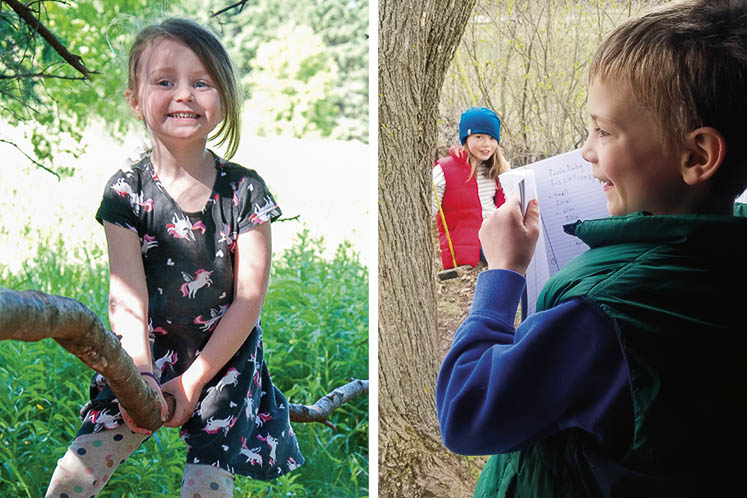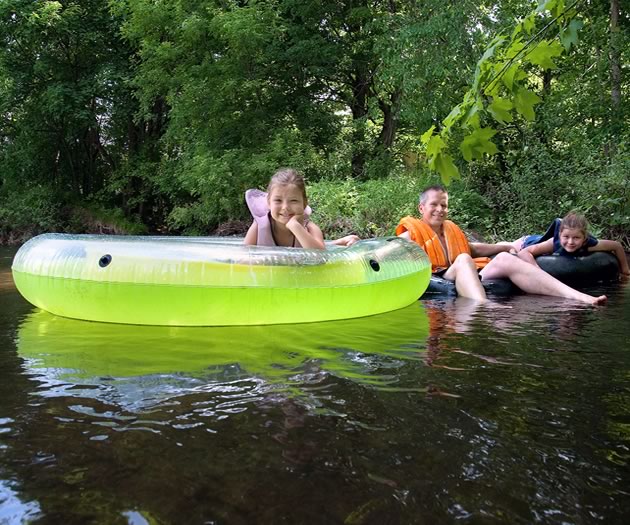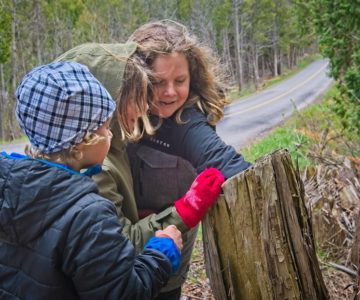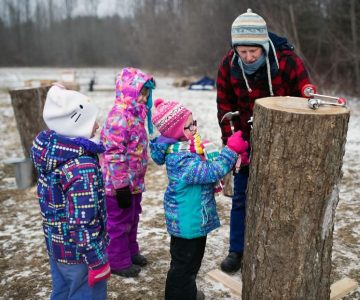Where The Wild Things Are
What the leaders, students and parents of local outdoor school programs want us to know about the power of outdoor learning.
Penning a script under the shade of a tree. Foraging for mushrooms and studying animal tracks. Painting the scenic vistas of the countryside. Staging a play in the great outdoors or learning to cook over a campfire. These sound like curated experiences from a bespoke travel company. But they’re activities commonplace to outdoor-focused schools in our area – and, advocates hope, the way of the future.
Even before the pandemic, parents and caregivers were facing a confluence of cultural developments – kids are spending less time in nature than previous generations, as noted among others by psychology researcher Peter Gray in his TEDx Talk titled The Decline of Play. Kids also spend less time on recess and physical education, and more time on the miniature screens designed to capture them.

Audrey (left) and Amaya explore leaf shapes at Headwater Hills Montessori School. Photo by Rosemary Hasner.
When I was growing up in the ’70s and ’80s there were always mud pies, a game of hide-and-seek or capture-the-flag among the trees, or any number of other casual outdoor activities to join. It’s a world away from what I see in both my neighbourhood and in the kids in my life. At the same time, there has been an increase in childhood obesity rates and diagnoses of childhood disorders and mental health problems.
In 2014 the largest U.S. private nonprofit conservation advocacy group, the National Wildlife Federation, painted a disturbing picture: “Our kids are out of shape, tuned out and stressed out, because they’re missing something essential to their health and development: connection to the natural world.” Research indicates that viewing, interacting with, and living in natural environments can reduce stress and increase patience, self-discipline, capacity for attention, and recovery from mental fatigue, crisis and psychophysiological imbalance.
And in Headwaters there is plenty of opportunity on that front. First, we have hiking trails, provincial parks and conservation areas on our doorstep, unlike so many of our urban neighbours. This summer kids across Headwaters had the most “normal” season in recent memory, returning to outdoor camps where they ran through the trees and got their hands dirty. And as the school year gets underway, many advocates suggest holding on to the weekend-hike, summer-camp mentality year-round. So, is it time we tried more experimental outdoor classrooms and move modern childhood in a different direction?
Toward an outdoor curriculum
At Headwater Hills Montessori School, which sits on a six-acre property just south of Orangeville, the youngest kids – ages three to six – spend two hours outside daily, and four hours during school-wide Forest Fridays. Howling like coyotes is common practice.
Teacher Regan Ross, who leads the youngest in what’s called the Casa program, recounts a particularly memorable day that illustrates the school’s promise. “The students started to build a ‘chocolate factory’ using fallen branches, logs and other found items in the forest. They had it all worked out – manufacturing, supply chain, warehousing, delivery, even waste disposal,” Ross says. “Then, when they wanted to take a break, they asked me to keep it running so that they didn’t get behind on orders.” If you’re keeping track, that’s imagination, planning, collaboration, problem solving, co-operation and accountability all in one.

Children gather in a circle at the Headwater Hills meeting spot to learn, sing and share. Photo by Rosemary Hasner.

Headwater Hills students make the trek to “the pit” for a snack around a campfire. Photo by Rosemary Hasner.
When Headwater Hills first opened in 2010, a grassy fenced play yard functioned in a traditional way for recess and games – and kids only occasionally ventured into the forest on the property. That changed nine years ago when the children themselves requested to have a recess in the forest. The immediate effects were astonishing, says school principal Nancy Ernst Richards. “The children’s play experience was much more creative and imaginative, as well as more collaborative, when they were out in the forest,” she says. “So, we decided to make the forest, and eventually the marsh and sandpit beyond, a regular part of our daily and year-round experience.”
Over time, she says, they began to see not only that the outdoor play was much richer, but in-class learning was enhanced too. Children had better focus, stronger empathy and interpersonal skills, and “brought a deeper contextual understanding to their learning, embedded in real-world discovery.”
That, and an appreciation for nature that future climate change fighters are going to need. “One recess, a few middle school boys noticed an insect infestation on the trees, and quickly organized a group to tackle the problem with loppers. From protecting habitat to putting on plays on the outdoor stage, day-to-day interactions within nature are student-initiated and reap a world of benefits,” Ernst Richards says.
Ross’s group follows the principles of the international educational movement known as Forest School. Forest School Canada was created in 2012 as an educational initiative of the Ottawa-area advocacy group Child & Nature Alliance of Canada, and it now oversees a program called Forest and Nature School (FNS), offering practitioner training, a certification course Ross completed in 2017.

Toddlers (aka Acorns) work together to move a giant log at At Last Forest School. Photo courtesy At Last Forest School.
“A primary tenet is that classes are child led. If there is a problem or issue, the children are empowered to work out the solutions,” Ernst Richards says. “We are there as guides and a resource, but the students take a large part in the responsibility – they become invested in the whole process. Everything is a learning experience.” Other Montessori schools often ask for tours as interest in starting similar programs grows.
Ross notes the physical benefits of staying outside so much, showing me the steep sides of “the pit” where campfires take place – as does sledding in the winter. “At the start of term, the new students can barely make it to the top, using their hands to assist. By the end of the year, they play tag on that hill like little mountain goats!”
As Ross’s work with the smaller kids took off, the school became more serious about developing outdoor learning programs for the whole student body, now about 45 children. By the time students are in Grades 6 to 8, much of the outdoor program involves off-campus fun. For example, students grow food at Mono’s Am Braigh Farm under the mentorship of organic farmer Jamie Richards (who is also Ernst Richards’ husband).

At Last Forest School students head out for a rocky hike. Photo courtesy At Last Forest School.
Caledon resident Jen Snelgrove is the mother of a five-year-old Casa student and says the program helps alleviate some of her major parenting concerns. “I worry about the state of the world today and think, ‘How do I teach my kids to handle the problems they will be faced with in the future?’” she says. “This program helps teach them how to handle challenges, problem solve and think critically, as well as have a great appreciation and respect for their peaceful surroundings. They are honing the skill of confident living in their natural environment.”
The gold (green!) standard
The Forest School philosophy and pedagogy has been around since the late 1950s, starting in Denmark and Sweden, and then moving through Scandinavia, Europe, China, Australia, New Zealand, the United States and Canada – with thousands of programs now worldwide.
Some outdoor education advocates may not follow the Forest School Canada methodology in a formal way, but they’re still all in. In this region one of the original outdoor schools is the Guelph Outdoor School, whose founder, Chris Green, grew up in Hillsburgh.
In the early 2000s, Green was a teacher at Brisbane Public School in Erin (where he had also gone to school), and noticed more and more cases of ADD and ADHD in his students. Around the same time, he encountered a growing body of research that linked the rise in those and other learning challenges to the marked decrease in outdoor play. His reading on the subject included the landmark book, Last Child in the Woods, by Richard Louv. In 2012, Green started the GOS with a vision of combating what Louv had coined “nature deficit disorder.”
Today GOS is a nonprofit that runs programs six days a week during the school year, most of them on its 13-acre property nestled in a cedar grove on the banks of the Eramosa River. The school serves more than 300 children from across Wellington, Caledon and Dufferin. Most families opt to attend one day a week as a complement to regular classroom learning.
While learning how to identify trees and running through a forest have many intellectual and physical benefits, Green says the mental health benefits are equally important. “By building nature connection into a child’s week, we are making sure their needs are being met on an ongoing basis, instead of addressing mental health problems as they show up and after the fact.”

London in a “sitting spot” to quietly observe nature at Headwater Hills. Photo by Rosemary Hasner.
Not surprisingly, GOS programs took off during the pandemic, when kids’ mental well-being was particularly stressed by fear and uncertainty about Covid, disrupted routines and social isolation – and when we were all reminded that gathering outside is immeasurably safer than in confined spaces.
“We’ve doubled – almost tripled – our programs and staffing inside the last two and a half years. The value of weekly outdoor experiences in a pandemic cannot be overstated,” Green says.
A flexible model
I feel the potential of these benefits – especially the power of tapping into kids’ internal motivations, which is a key principle of the Forest School model and outdoor schools in general – when my 12-year-old daughter and I visit Jenny Lorito, the director and lead instructor at The Raise-An-Artist Project at the school’s rural property near Erin. Lorito asks my daughter what she loves, what’s she’s into, what she would like to try, do or create – anything at all. Her answers range from drawing wildflowers to making jewelry, and it’s all fair game here, where most of the learning happens under the clear blue sky. Most of Lorito’s students – she’s had up to 30 at a time – attend the program one day a week, with a daily cap at six students.
Lorito’s art-based programs have incorporated the great outdoors since she began in 2006. Students and campers spend a great deal of time hiking the Bruce Trail, but they also find ways to take everything outside.

Elyn Huws-Oussoren in action at The Raise-An-Artist Project. Photo courtesy The Raise-An-Artist Project.
“When we are outdoors and part of a community where we feel we can be ourselves and are supported, learning comes much easier,” says Lorito, echoing her colleagues at other schools. “We are all about guiding individuals to make their own choices, to help them learn how they learn so that they can set goals and achieve them. Frustration often comes from imposed expectations. Here we foster internal motivation.”
One day you might see a giant loom supported by trees, constructed to enable a collaborative weaving piece. Instructors read aloud to children gazing at the clouds. Students write poetry in the forest, perform theatre on the lawn, or set up for painting en plein air. Oh, and foraging and cooking if that’s where a student’s passion takes her.
“Jenny is always there for you if you need her. I love working one on one with her and she helps me reach my goals,” says Sophia, a Grade 7 Georgetown-based student at the school. “Everyone is so accepting of each other. I love getting dirty and no one will care!”
Orangeville parent and In The Hills contributor Johanna Bernhardt says her son, who is in Grade 6, is thriving in Lorito’s program. “Being connected to nature helps him sharpen his senses, develop body awareness, while also tuning in to the natural rhythms of the earth. You can cope with life’s challenges a lot better when you recognize that there is a season for everything.”
It’s still academic
At Orangeville’s At Last Forest School, all that forest bathing comes with a good dose of science, reading and mathematics on its Island Lake Conservation Area campus. After opening in Owen Sound in 2016, the FNS-accredited At Last has now expanded to 12 stand-alone schools across Ontario. The Orangeville location hosts about 14 students a day, in full- and half-day programs, four days a week. The school’s retrofitted trailer is its only indoor space, used in inclement weather.
“It’s very neat, as a teacher, to watch students use intellectual skills they’ve learned and observe the moment of ‘Wow, I didn’t realize that is how it actually works,’” says operations manager and teacher Christine Brown. One memorable example for her was watching a student analyze sap on a tree and noting it wasn’t there the week before. “After asking what had changed, they realized the temperature had warmed up. They had learned about maple syrup in school, but didn’t think that was actually what happened to the trees! Their bright smile following the connection was amazing.”
These kind of lightbulb moments should dispel any worries about the impact of a day away from the traditional classroom. In fact, the more I learn, the more I’m loath to even use the phrase “missing a day” – there is no missing out here. Indeed, teachers and traditional schools have even reached out to At Last for professional development. Inquiry-based learning, after all, is a significant component of the Ontario curriculum.

Leila creates her own play structure in the trees at Headwater Hills Montessori School. Photo by Rosemary Hasner.
“We’ve provided workshops and webinars on incorporating the outdoors into everyday curriculum at a traditional school without them having to replan everything,” says Brown. “We have also conducted field trips; school board teachers have mentioned these are great ways for them to see how outdoor learning works with a Forest School teacher leading.”
In addition to the tenets of Forest School I’ve encountered thus far, Brown introduces me to the “art of questioning,” a teaching technique that nudges kids to answer their own questions. “Say, for example, a student found some tracks in the mud and wanted to know the animal that made them. Instead of just saying, ‘Oh, it’s a deer,’ and walking away, we ask them, ‘What do you think it is?’” explains Brown. “Then we analyze together, asking, ‘Does it look big or small? Where do you think it was going? Do you think it was running or walking? Does it have a large gait or space between footprints – do you think it has long legs?’ and so on. They learn so much and work on problem-solving skills, plus are typically pretty proud of themselves if they figure it out.”
The school also leans into providing tools for “risky play,” meaning play by which students can take safe risks, another core Forest School concept. “Things like hammers and nails, handsaws, two-person saws, whittling knives, and flint and steel are a few favourites. Many students have the goal to start a fire with the flint and steel.”
Year-round fun
Sunny Septembers are one thing, but I do wonder about shipping kids outside when the thermometer plunges or the rains of spring strike. As usual, I’m thinking like an adult, not seeing the world of possibility. The educators I spoke to shrugged it off. At Raise-An-Artist, snow is the perfect medium for sculpture. At Headwater Hills, “The snow and colder weather make for endless opportunities including animal tracking, using tools to lop branches and saw wood for building a campfire, cooking bannock over the fire, creating ice and snow art, making bird feeders, bird watching, winter camouflage, hibernation games and much more,” says Ross. “Every year around this time I start to get excited and think, I can’t wait for winter at school.”

Headwater Hills student Morgan bounces on a tree branch, at left, and Elyn and Reed Huws-Oussoren head outside at The Raise-An-Artist Project. Photo courtesy The Raise-An-Artist Project.
What’s more, a take-charge ingenuity often emerges. Ernst Richards recalls her elementary students’ beloved fort became inaccessible after spring flooding last year. Not to be deterred, the students stacked foam toboggans, then stood on them and propelled themselves, gondola-style, across the moat.
Internationally, Forest School pupils spend 80 to 90 per cent of the school day outdoors. In Germany, many of the more than 700 forest kindergartens even forego heated indoor facilities entirely; instead, incorporating tool sheds, tents, outdoor toilets, yurts and open shelters with firepits. I imagine they’re not obsessively checking for Wi-Fi there; their connection is all natural.
Preparing for the new normal
So, will we be seeing more outdoor education opportunities popping up in Headwaters? There’s no doubt it’s on the minds of local innovators. “As we watch global trends in the economy, technology, society and climate, many of us are getting the sense that the classroom no longer prepares children for the near future,” says Guelph Outdoor School’s Chris Green. What he’s seeing are parents and children craving community, co-operation, justice, connection, healing and self-expression through engaging with the outdoors.
Local public school boards are also tapping into facilities at provincial parks and conservation areas, including Mono Cliffs Outdoor Education Centre and Terra Cotta Conservation Area, for field trips and professional development for educators – all linked back to students’ current curriculum. And postpandemic, some schools, such as Caledon’s Belfountain Public School and others, have deepened their outdoor education commitments, holding more classes outdoors than ever.
Belfountain principal Heather Little says the school’s location helps. “Our staff take full advantage of our spectacular school grounds and the surrounding conservation lands to plan outdoor learning experiences that bring the curriculum to life for our students,” she says. “From learning about the plant and animal species that inhabit the stream and forest areas, and how to continue to make them grow and thrive, to learning about which plants the Indigenous People before us on this land used to make medicine as part of the health curriculum, we incorporate as many outdoor experiences into students’ daily tasks as possible.” Belfountain continues to be a pilot school for national charity Learning for a Sustainable Future and is committed to incorporating the UN’s Sustainable Development Goals into their curriculum, she adds.
Still, Green says he’s hoping for more. “We can appreciate the work of dedicated educators in the classroom and hold in the other hand the truth that something needs to change. It may be that we do not yet know what education will look like in 20 years, or 50, but people seem ready to start asking questions and trying things on.”
While we wait to see if outdoor schooling goes mainstream, Headwater Hills’ Ernst Richards and Ross are quick to stress that families can create this type of experience on their own. This is music to my ears as I’ve been feeling regret about all the years of missed opportunities in outdoor education for me and my kids.
But there’s some good news about my efforts to instill in them a love of hiking my favourite local spots, like the Bruce Trail’s Split Rock Narrows and Island Lake Conservation Area. FNS principles recommend visiting the same spots many different times to appreciate changes over time. Says Ernst Richards, “We get caught up in thinking that we need to expose children to variety, whereas there is a deeper connection to be found in returning to the same place, noticing and getting to know it through the seasons and falling in love with it.”

Xavier (top) and Logan peek out from their “pirate ship” at Headwater Hills Montessori School. Photo by Rosemary Hasner.
She suggests visiting any patch of wild and letting your child lead. You don’t need to prepare a lesson – the lessons reveal themselves, she says, urging parents to be “joyful co-discoverers” rather than leaders. Turn over a log and see what’s beneath or take the time to really look at a leaf. Sit quietly in one spot for five minutes and sense nature around you. “Allow wonder and awe to touch you. Let go of your goals, let go of thinking there always needs to be a trail completed or something tangible achieved.”
Ahhh. I’m starting to realize outdoor education is as much about unlearning that strict, goal-achievement mindset as it is about connecting with nature. At the same time, there is something of a sleight of hand inherent in all this free-flowing, child-led inquiry. Students are, in fact, achieving the kinds of goals we hope for.
Ernst Richards tells me her middle school students chose their own field trip and planned it from start to finish last year. They voted for an overnight camping trip to Albion Hills Conservation Park, called to make the campsite reservation, applied for the permits and did all the meal planning and cooking. Now, that’s another thing I’d like to try at home.
Related Stories

Get the Kids Outside!
Jun 16, 2015 | | LeisureThe Nature Fix: 12 ways to get the kids outside this summer and unleash your own inner kid.

How Will Our Kids Align Their Stars?
Sep 20, 2022 | | Headwaters Nest“What do you want to be when you grow up?” It’s such a familiar question. We throw it out to the littlest of our littles, as early as age three or four, once their interests start to sparkle.

Geocaching Treasure Hunt
Jun 22, 2021 | | Good SportA thoroughly modern treasure hunt is a surefire way to get kids busy outdoors.

Let It Snow: Try These 10 Kids’ Winter Activities
Nov 22, 2017 | | LeisureEmbrace the season with snow tubing, tuning into nature or warming up indoors with a zany DIY parlour game.









